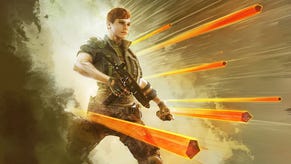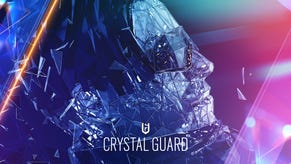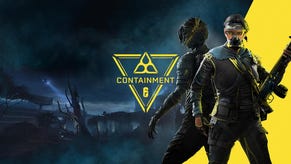Rainbow Six: Siege PC Review: Tense, Tactical Shooter
Ubisoft's asymmetrical multiplayer series returns after a seven-year absence. Has it been worth the wait?
This article first appeared on USgamer, a partner publication of VG247. Some content, such as this article, has been migrated to VG247 for posterity after USgamer's closure - but it has not been edited or further vetted by the VG247 team.
This is a slightly odd review, because it's going to start with impressions based on eight hours spent with the game at a recent review event at Ubisoft's offices. I'll then continue to build out this piece by adding further thoughts as I play through the PS4 production copy of the game that arrived today.
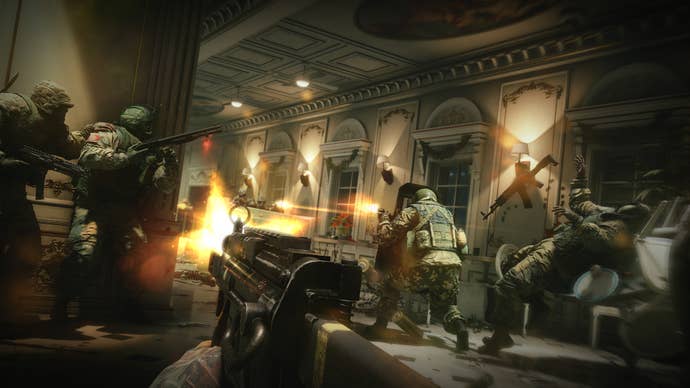
There were ten of us at the review event, all playing a fully unlocked PC version of the game, and we dipped into all aspects of Rainbow Six: Siege during the day, starting with Situations, the single-player mode.
This is essentially a series of training exercises – ten missions (plus one bonus mission) that take place on the game's eleven maps. Each Situation has one over-arching goal, and a couple of sub-objectives that are optional, but earn you extra xp and renown for completing them. Renown is game currency that's used to unlock operators, weapons skins and attachments, while xp unlocks ranked PvP mode (at level 25).
Something I did notice when I was playing around with the game before we started is that microtransactions are present in Rainbow Six: Siege. There are different skins and weapon graphics that you can buy – as well as a renown booster that essentially increases the rate at which you earn that currency. I want to explore this further when I play the production copy of the game to see exactly what this is, but I did find it a little off-putting. I can understand this sort of mechanic in a free-to-play game like World of Tanks – you can buy experience boosters in Wargaming's excellent tank battle game – but in a full-priced game it just seems out of place.
More on that later, but for now I'll get back to the review day and Situations.
These missions are designed to ease you into Rainbow Six: Siege's gameplay by teaching you its combat basics. Things start out easy enough with a simple assassination exercise that takes place in a training facility, but quickly ramp up with a hostage rescue, and a scenario where you have to defuse a bomb. I did find Situations missions are mostly a game of trial and error. There's little in the way of randomization, and as long as you follow roughly the same path each time you tackle them – assuming that path is a good one – you'll largely have the same kind of experience in terms of where enemies are camped, and where there might be booby-traps and the like. That means completing each mission basically involves you finding and memorizing the optimal path through the level.

Because of this, I found some missions felt a little rote in nature. Sure, they're still reasonably enjoyable and rewarding to play, but to me they seemed to be more of a test of memory than reflexes and ingenuity. Perhaps if things were more randomized like they are in the multiplayer side of the game, it would have made Situations more tense and gripping. Instead, I found they started off tense, but once I began to learn where everything was, that dialed down the element of surprise, because I knew exactly what was around the next corner. Still, Situations does a good job in helping you learn how to play the game, even if it's not its most enjoyable aspect.
After playing through this single-player part of the game for a couple of hours, we then moved to Terrorist Hunt – which I found was a lot more enjoyable than Situations. Although it can apparently be played in single-player mode, we played co-op with five of us playing against a team of five AI bots. There are four different kinds of asymmetrical missions – Protect Asset, Disarm Bombs, Hostage Extraction and Classic – and once the mission brief is given, you have a short amount of time to prepare to either assault the AI team, or defend against them, depending on the mission type.
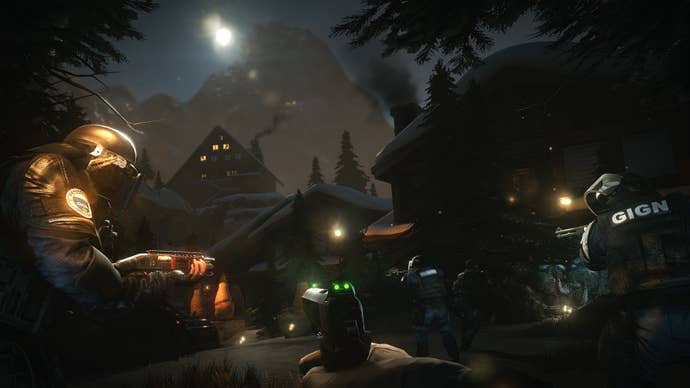
It's in this mode where Rainbow Six: Siege's game pillars of tactics, tension and team play really came into effect. In terms of team play and tactics, we needed to work together to execute a plan to achieve the mission objective, and that required us to communicate – something that was made easy by the fact that we were all on voice chat. As we played through various missions, we constantly kept one another updated on what each of us was doing, and that helped us maintain a winning streak on the "normal" difficulty setting. Then we upped the difficulty setting to "hard" and had a much tougher time completing missions successfully. What's clear is that on the normal difficulty setting, the bots are only reasonably accurate, and you have a decent amount of time to line up a shot to take them out – but turn the difficulty up a notch, and the AI will shoot you down very quickly if you give them half a chance.
What I like about Terrorist Hunt – and indeed this view extends to the regular multiplayer PvP too – is that the game is very tense from the very beginning of a mission all the way through to the end. If you're attacking, you can scout the target location using a small drone vehicle – you only have a short time to do this, so the pressure is on to quickly see as much as possible before the drone timer expires. If you're on defense, you need to quickly barricade doors and windows and set traps to secure a defensive perimeter, and then find a good position where you can fend off the attackers. Then there's a period of waiting while you either start working your way through the building you're attacking – not knowing if you're about to be ambushed by defenders – or, if you're defending, you sit and wait for the attackers to make their move. The feeling of tension is palpable during this time – everyone involved is waiting for the moment they make contact with the enemy, and that's when all hell breaks loose.

Rainbow Six: Siege's destructible environments really come into play here. As well as breaking through doors, windows and some walls, it's also possible for certain operators to destroy barricades using specific pieces of equipment. This basically opens up the environment and makes it very difficult to predict where an attack might come from. It also makes you think very differently about how you approach the game. In most tactical shooters, it's all about getting an enemy in line of sight and shooting at them. Here, you can actually take out another player by shooting them through a wall – but obviously you don't want to just shoot blindly, otherwise you'll quickly run out of ammo and be a sitting duck.

The way I'm describing the game sounds quite chaotic, but it's only so when the two teams engage one another. Most of the time it's simply tense. Threats can come from anywhere, which means you need to constantly think and be aware of what you're doing while moving through the game's environments. This isn't a game where you go rushing in headlong, with all guns blazing. Do that and you're probably going to be dead in very short order. Instead, you need to think a couple of steps ahead, and be prepared for what might be around the next corner – or behind the next wall.
Multiplayer PvP follows the same format as Terrorist Hunt, only this time it's two teams of humans playing against one another over three different modes: hostage, bomb and secure area. This was definitely the most fun part of the day, and we spent a good four-or-so hours playing through this mode. While the AI bots in Terrorist Hunt are pretty good opposition, there's no substitution for human players to add an extra degree of randomness and smart thinking to the proceedings, and we had some great games against the opposition.
Review Day Takeaway
Rainbow Six: Siege is definitely at its best in its multiplayer PvP mode. Squaring off against five other players in a battle where you don't get any respawns makes for some really tense and exciting action. The destructible environments are key to adding a new dimension to the gameplay, and really open the game up to some interesting tactical approaches. Rainbow Six: Siege is definitely a very different beast to most FPS games, which helps it carve out its own niche in the genre - if you're after a more thoughtful, tactical, tense and exciting shooter, this is definitely the one to have.
Launch Day
I've been playing the PS4 version of Rainbow Six: Siege today, and my initial reaction wasn't favorable. Aiming feels very different to the PC version, and it took a lot of fiddling with the dead zone and X and Y speed settings to get the gun into a place that felt comfortable for me. It's just very light and wafty, and I initially found I constantly over-aimed and couldn't center the gun reticle on the targets I was trying to hit, which was frustrating.
Your mileage might vary of course, and you may like the general feel of aiming, but for me – and perhaps it's because I've spent the last week putting many hours into Call of Duty: Black Ops III and I'm just used to the incredibly accurate way that game feels – it's taking me a lot longer to get used to Rainbow Six: Siege's gunplay than I'd like. After a few hours, I'm finally in a decent place where the gun feels just about right, but it's still not 100% perfect.
What I can't quite understand is that I had no problem picking up and playing the PC version – I used an Xbox One controller at the review event, and aiming with that was great. Why the PS4 version is different I have no idea, but it just doesn't feel quite as good as the PC game.
The speed at which you earn renown is fairly slow and steady in single-player mode. I'm sure if there wasn't a renown booster available for purchase, I probably wouldn't think about it too much, but that it's available means I'm always aware that I'm earning renown at a sub-optimal rate. To be absolutely blunt, I just find it annoying that I'm playing a full-priced game and can pay extra to earn renown and unlock things quicker. Like I said yesterday, I can understand it in a free-to-play game like World of Tanks, but in a premium game it just seems incongruous. I guess that's the downside of the game's upcoming DLC maps being free – Ubisoft is looking to make money elsewhere. Still, in both online modes, renown is earned quite quickly, so assuming you're happy playing online, I don't think the booster is a necessary purchase.

Speaking of playing online, the other thing I was surprised to find, and maybe I'm wrong here, but try as I might I couldn't find a way around it, is that the game requires you to have a Uplay account to play online. I tried to play without signing up, but every time I hit cancel, I ended up back at the select screen. So I signed up – which is something I just found irritating I had to do. Sure, it's only an email address, and I can always unsubscribe to the inevitable marketing messages I'll get, but being forced to sign up for something that I'm not really interested in just so I can play online feels like a bit of a liberty to me.
Those annoyances aside, the PS4 version of Rainbow Six: Siege basically plays the same way as the PC version, odd gun feel notwithstanding. Going back to the single-player mode and playing through Situations again reinforced the feeling that this is definitely the weakest aspect of the game. While there are some cutscenes to tell you what you need to do, there's no real story to the game – surprising considering its Tom Clancy heritage – and Situations ultimately feel like glorified training missions to set you up for the "real" game, which is essentially the two online modes. Like I said yesterday, working through Situations, especially the tougher later missions, often feels like a case of trial and error as you attempt to find the optimal path through them. I just didn't find this mode particularly fun or compelling.

Terrorist Hunt and Multiplayer PvP are like night and day comparatively: they both offer action that's tense, exciting and fun. Playing online today was a bit hit-and-miss. I had a few games plagued with lag, but I eventually hit a streak where everything worked fine. What's interesting playing online at home is that very few people are communicating, so in most games, the "team" was just working as individuals. This is definitely a different experience than the review day, where we were all on voice chat and constantly talking to one another about what we were doing, but I think it's probably how most people will play the game.
What I initially found is that people aren't really playing to their operators' strengths yet – which again is part of the lack of teamwork. I had one game where one player had a shield, but nobody except me stuck with him. Fortunately we ended up taking out three enemies while the rest of the team dispatched the other two opposing players, but it's just an example of how most people are playing this game: a little less tactically as a team, and more seat-of-the-pants.

Fortunately, while there is definitely a lot of fun to be had working as a team and communicating properly, the game doesn't lose too much when everybody is silent. It's still a very tense game of cat-and-mouse, with the attackers slowly making their way to their target while the defenders lie in wait. Like I said yesterday, only having one life and no respawns definitely helps raise the stakes, and while you play, you tend to move forward quite slowly, checking around corners carefully to ensure there are no enemy players present. This slow, more methodical approach to the game definitely helps it stand apart from most run-and-gun FPS titles, and gives it a unique feel.

Conclusion
Rainbow Six: Siege's single-player mode isn't particularly compelling. Situations feels like a series of training missions that exist only to prepare you for the multiplayer main events: Terrorist Hunt and PvP. Fortunately, those two latter modes are excellent, and offer a great deal of tactical depth. Playing as a team is a lot of fun, and while the experience can vary greatly depending on who you're grouped up with, what's clear is that when everything comes together, Rainbow Six: Siege is a really tense, thrilling and exciting first-person shooter that has a very different approach and style to most other FPS titles. It's a truly strategic game whose very well designed environments facilitate some terrific encounters, from intense firefights in close quarters to protracted games of cat-and-mouse as individuals sweep rooms looking for one another.
Graphically, the game is solid. It's not quite up there with the likes of Call of Duty: Black Ops III in terms of its lighting and detailing, but it's definitely good enough. The environments are well rendered and the motion capture of the operatives is great, however.

A special mention should go to the sound, which is absolutely top-notch. From muffled explosions heard through walls to the sound of people making their way through the buildings, you can really use the audio to your advantage. It's incredibly realistic and very well designed so that listening to the game is just as important as watching it. Indeed, the sound can really ratchet up the tension as you hear the other team approaching your location.
That tension is one of the key elements of Rainbow Six: Siege. The destructible environments add a whole new dimension to the game, and make you think very differently about how you can approach both attacking and defending a position. Add to that the single-life/no respawn element of the gameplay and you have a truly high-stakes game that can deliver some very exciting action.
On the downside, the game only has eleven maps, so its content does feel a little on the slim side. Still, with four sets of free maps promised over the next year, Rainbow Six: Siege will build out to feel a lot more substantial than it does today. It's not like it's super-limited at the moment, but there's definitely some repetition when you play.
Ultimately, Rainbow Six: Siege is a really solid and enjoyable tactical shooter that doesn't play like an average FPS game – it's far more tense, thoughtful and tactical than most run-and-gun games. Like I said in the review day takeaway, this helps it carve a niche out for itself and makes it a worthwhile purchase if you're after a shooter that's a little different to the norm. It's especially recommended if you have a group of friends that you can play with, but even on your own it can be a lot of fun.
InterfaceSmart-looking screens get you around the game with ease.
Lasting AppealThe game has a limited number of maps at launch, but there are four sets of free content scheduled for the next twelve months.
SoundTruly excellent sound makes listening to the game just as important as watching it.
VisualsSolid. The environments are nicely rendered, and the operatives are very well detailed.
ConclusionAlthough the single-player side of the game is weak, Rainbow Six: Siege's multiplayer modes are a huge amount of fun. Tense, thoughtful, and tactical, they play very differently to most run-and-gun shooters. While the game's content does feel a little slim at launch, there's no denying it's highly enjoyable to play - especially when you have a team of players working together.


.jpg?width=291&height=164&fit=crop&quality=80&format=jpg&auto=webp)


